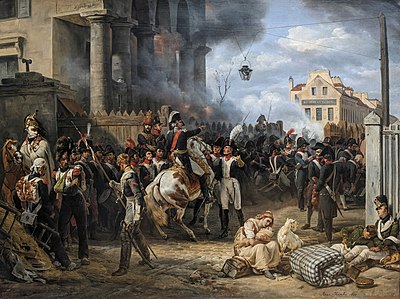The Barrière de Clichy. Defence of Paris, 30 March 1814 is an oil on canvas painting by Horace Vernet, from 1820. It shows a battle against Russian cossacks at the barrière de Clichy (part of the Battle of Paris).[1]

It was commissioned by the goldsmith Jean-Baptiste-Claude Odiot, who like Vernet had fought in it under Bon-Adrien Jeannot de Moncey.[2][3][4] Odiot gave the work to the Chambre des Pairs in 1835, then it was transferred to the musée du Luxembourg two years later and its current owner the Louvre in 1874.[3][5]
Description
editReception and influences
editIt was refused by the 1822 Paris Salon for political reasons - in effect - Vernet was then a protégé of the duc d'Orléans and the favoured painter of the opposition.[2] For Malika Dorbani-Bouabdellah, scientific collaborator at the Louvre's paintnigs department, the work "translates the troops' despair, their last noble, courageous but betrayed effort". His painting of the battle of Jemappes evokes the first victories of the French Revolution in 1792 and Barrière that Revolution's last expression - "The painting is a show of patriotism which raises the defeat of the [1814] campaign in France to a glorious and raises the painted work to the rank of a historic work".[6]
A study of Vernet's painting titled The Wounded Cuirassier (initially titled Portrait of Colonel de Moncey, although he was a hussar not a cuirassier) is attributed to Théodore Géricault, who had close links with Horace's father Carle Vernet. Carle and Géricault shared a passion for horses and military campaigns. It is now in the musée des beaux-arts de Dijon.[7]
Around 1826 Jean-Pierre-Marie Jazet produced an engraving of Vernet's work.[8] Alexandre Dumas premiered the five-act military play La barrière de Clichy in 1851 at the théâtre des Batignolles (now the théâtre Hébertot), consisting of fifteen tableaux. The last tableau of its third act, Tableau de la barrière de Clichy, inspired by Vernet's painting and giving the play as a whole its title.[9] One of the 1869 bas-reliefs on the monument to marshal Moncey on Place de Clichy also uses the painting's composition.
References
edit- ^ (in French) "Base Joconde entry".
- ^ a b (in French) François de Vergnette La Barrière de Clichy - Défense de Paris, le 30 mars 1814 Musée du Louvre
- ^ a b (in French) Irène Delage La Barrière de Clichy. Défense de Paris, le 30 mars 1814 Napoléon.org, 11 January 2013
- ^ (in French) Horace Vernet, 1789 - 1863
- ^ (in French) "Catalogue entry".
- ^ (in French) Malika Dorbani-Bouabdeellah La défaite de l'Empire
- ^ (in French) Valcauda Sophie and Bardin Dominique Le Cuirassier blessé ; Portrait du colonel de Moncey (ancien titre)
- ^ (in French) La barrière de Clichy ou défense de Paris le 30 mars 1814
- ^ (in French) La barrière de Clichy